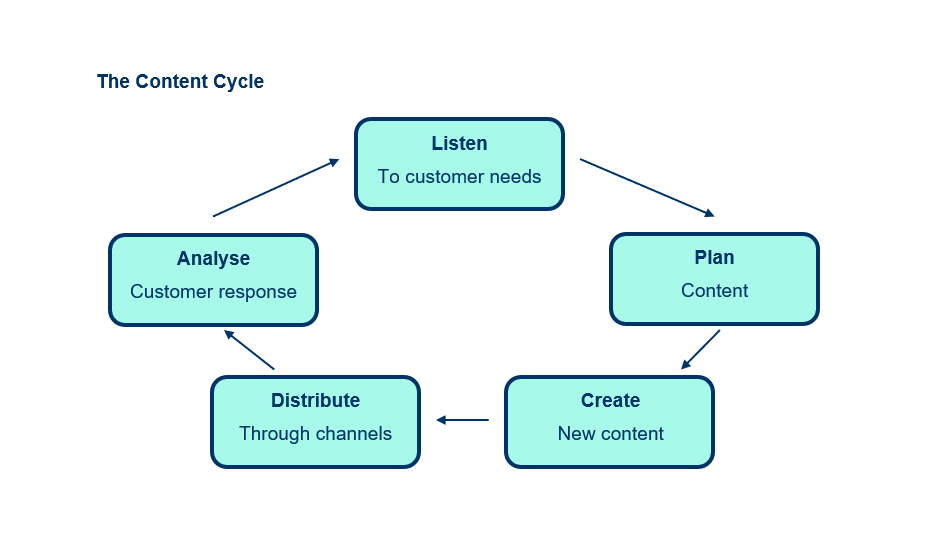WIRED WORDSMITH
TECH
CONTENT
Producing Consistently Effective Content: The Digital Content Cycle

Listen – Plan – Create – Distribute – Analyse - Listen …
To be continuously effective in terms of marketing and search engine optimisation, online content plans must be regular and cyclic. Content must be produced and responses to it must be analysed in order that the next lot of content addresses customer wants and needs even more effectively. Then that content gets responded to in turn and the whole process starts again. There can be some planned exceptions for notable, important events and news, but even these must benefit from customer feedback. Following this golden rule makes the process of content creation much more efficient and responsive[1].
To help you keep your content consistently on point, we've laid out the stages of the cycle below.

1. Listen to customer information needs
Producing content is like producing anything for public consumption; Before anything else is done, the needs of the consumer or audience must be analysed. Generally, this is done by assembling all the information you have on customers, including analytics (from step five - Remember it's a cycle), market research and any other sources of customer knowledge in the company. The goal is to reveal what your site visitors and prospects want and need to hear; their entertainment and education demands.
This must be used to compose the ideal content schedule, the most relevant and popular topics and the best way to engage the customer[2]. Here, it is important to go beyond numbers, equations and user journeys to create a meaningful view of the customer’s needs that can be used. The more sources of information there are, and the more carefully they are considered, the better.
2. Plan content
The revelations from step one must be used to create a content schedule that is engaging, relevant and effective in selling the product. It's important to also plan goals for your content that are specifically relevant, measurable, achievable, realistic and timely. This type of goal setting is important to efficient digital marketing[3].
Of course, the content must be planned and scheduled. Depending on your resources your online content should include a source (such as a blog) that is updated weekly, bi-weekly or monthly in order to be effective. Any less regularly and customers won't be interested while search engines will start to ignore you.
Planning blogs, vlogs, social media and other user-oriented content
Generally speaking, there are five types of content that should appear in these places regularly for it to be consistently balanced and appealing to everyone:
Value content - These are bits of advice and education that are given freely without any overt advertising, promotion or calls to action, much like this article. This content leads customers to appreciate what you're giving away and rely on you as an educator.
Educational content - More in-depth educational articles that may contain promotions or calls to action. You are still building yourself up as a provider, but you're asking for something in exchange.
Entertaining content - All work and no play makes Jack a dull boy. Your visitors and prospects want to be entertained as well as informed. Include fun stories of life at your business, industry in-jokes, interesting titbits, videos and images. Just make sure it's entertaining!
Motivational content - At its heart, good content fulfils human needs, and we all need to be inspired once in a while. Remind your visitors and customers that what they're doing is worthwhile, tell them life is good and give them something to aspire to.
Promotional content - At the end of the day, you're probably looking to promote something, so do remember to do this. Just ensure that less than 20% of your content, or one in five posts, are overtly promotional. Otherwise, your content becomes an extension of your advertising campaign and loses its attraction.
All content falls into these five fields, and a good balance of each makes for an attractive blog, vlog, social media feed, or whatever. You may want to rebalance your content slightly depending on your industry, user responses and situation. It's worthwhile covering all bases though so you have something to appeal to everyone in any mood and an even five-way split is a good place to start.
3. Create content
The content-creation process must, of course, be creative, but it must also be customer and goal focused, leveraging the analysis and consideration carried out in the previous steps to achieve marketing goals. An engaging start and a call to action at the end are important.
Every part of your online presence should be interlinked with the aim of turning casual browsers and searchers into definite customers. Your blogs, vlogs and posts are no different to this, except they provide more qualitative ways to engage visitors who are not necessarily browsing for your offering, or shopping at all. They do this by providing users with content they will like, use and find valuable, which is also relevant to your company and product.
This inbound content provides your company with the opportunity to leverage its existing online authority and respect as a marketing tool, creating a platform for it to make reliable statements to consumers that will draw them onto the site.
4. Distribute
The content must be distributed in a way that reaches and engages the maximum number of interested, valuable customers possible, and hopefully convert them into customers. Even great content falls flat if it isn’t shown to the right people. Distribution can happen through social media shares, search engine optimisation, marketing, advertising (online and off), strategic distribution through connections and groups and word of mouth. Whatever you do, spend some time thinking of who will be interested, who you want to be interested and how you will reach them.
There are also questions of timing. This is not an exact science, but Wednesday at 12 pm tends the best time to capture a business and professional audience while Saturday at 11 am is the best time to hit customers with personal advertising. Meanwhile, late Monday morning is the better for putting out motivational content and getting prospects to make plans (to attend an event you're announcing, for example).
5. Analyse response
This is the stage of the cycle that is most often missed. It's also the one that makes the biggest difference between space-filling blogs and ones that add real, significant value for site owners, businesses and browsers.
To ensure your content is effective and valuable, you need to analyse several stages and types of customer interaction with your content. Then the products of these analyses must be converted into useful information. This is where analytics comes in - something that can (and will) take up a whole blog series in itself. For now, we'll tell you that analysis can be broken down into a smaller process of analytics > interpretation > evaluation > strategy or: What is happening with our content? What does it mean? What is it worth? And how do we increase the value?
Start by setting goals: What do you want your content to do and how can you find out how well it is doing this using analytics?
At a minimum, a thorough analysis must involve the total size of the audience that views the content, where they come from (search engines etc.) the number who are engaged (who scroll down and stay on the page long enough to read the article in-depth), the value of their engagement ,the most popular articles, the number who follow the preferred course of action (going to the site or making a purchase etc.), and where other users go from the page. Google Analytics is a great way to gather this information, but again, don't stop at gathering the information. Use it to figure out how well your content is achieving your goals and, if you are in business, what value it is generating for your company. We'll have more on this soon.
Back to stage one again
This is a consistent process. Small organisations can plan regular sequences of reviews and feedback, while larger ones often undertake all the steps simultaneously and consistently, feeding information from one department to the other.
Whatever you decide to do, undertaking this process fully and faithfully is key to having an effective blog that brings visitors in, builds trusting, engaged relationships and ultimately turns them into faithful customers. The difference between a blog created using this cycle and one created from random posts is astonishing in terms of efficacy, so think about taking some time to set up this cycle and get in touch with us on mail@wireframe.com if you have any questions.
Reference List
As this is loosely based on a report we created recently, we've provided a few of our very useful references below. Anyone investing or expanding into this area should check these out.
[1] Halverson, K. & Rach, M. (2012)
Content Strategy for the Web. Berkley: New Riders
[2] Chaffey, D., Ellis-Chadwick, F., Mayer, R. & Johnston, K. (2007) “Delivering the Online Customer Experience” in. Internet Marketing: Strategy, Implementation and Practice. London: Prentice Hall
[3] Chaffey, D. & Smith, P. R. (2019) Digital Marketing Excellence: Planning, Optimizing and Integrating Online Marketing. London: Routledge: pp. 579-581
All Rights Reserved - Wired Wordsmiths is copyrighted to Wireframe Partners Limited | Privacy Policy



